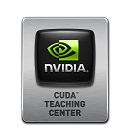Difference between revisions of "GPU610/DPS915"
(→Resources) |
(→The Assignments) |
||
| Line 56: | Line 56: | ||
* Grading - The window for submission of each workshop is one week plus a day from the date of the workshop period. The penalty for late submission is 50% of the workshop mark. | * Grading - The window for submission of each workshop is one week plus a day from the date of the workshop period. The penalty for late submission is 50% of the workshop mark. | ||
| − | == | + | == Assignments == |
# [https://scs.senecac.on.ca/~gpu610/pages/assignments/a1.html Selection and Assessment] | # [https://scs.senecac.on.ca/~gpu610/pages/assignments/a1.html Selection and Assessment] | ||
# [https://scs.senecac.on.ca/~gpu610/pages/assignments/a2.html GPU Programming] | # [https://scs.senecac.on.ca/~gpu610/pages/assignments/a2.html GPU Programming] | ||
Revision as of 18:27, 9 January 2013
GPU610/DPS915 | Student List | Group and Project Index | Student Resources | Glossary
Please help make this page resourceful for all GPU610/DPS915 students to use!
Contents
Course Material
GPU610 - Parallel Programming Fundamentals
|
DPS915 - Introduction to Parallel Programming
|
External Links
The Workshops
- The workshops provide timely opportunities to implement some of the material covered during the lectures. Each workshop is graded and all submissions are through Moodle.
- Detail Specifications
- Grading - The window for submission of each workshop is one week plus a day from the date of the workshop period. The penalty for late submission is 50% of the workshop mark.
Assignments
Evaluation
- Assignments and Presentation 30%
- Workshops 20%
- Test 20%
- Exam 30%
Resources
- Software Support
- Wikis
